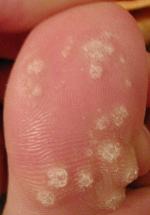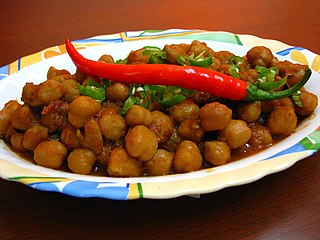| Chickpea filiform virus (CpFV) | |
|---|---|
| Virus classification | |
| Group: | Group IV ((+)ssRNA) |
| Family: | |
| Genus: | |
| Species: | Chickpea filiform virus |
Chickpea filiform virus (CpFV) is a plant pathogenic virus of the family Potyviridae.

Warts are typically small, rough, hard growths that are similar in color to the rest of the skin. They typically do not result in other symptoms, except when on the bottom of the feet, where they may be painful. While they usually occur on the hands and feet, they can also affect other locations. One or many warts may appear. They are not cancerous.

The chickpea or chick pea is an annual legume of the family Fabaceae, subfamily Faboideae. Its different types are variously known as gram or Bengal gram, garbanzo or garbanzo bean, or Egyptian pea. Chickpea seeds are high in protein. It is one of the earliest cultivated legumes, and 7500-year-old remains have been found in the Middle East.

Hummus is a Middle Eastern dip, spread, or savory dish made from cooked, mashed chickpeas blended with tahini, lemon juice, and garlic. The standard garnish in the Middle East includes olive oil, a few whole chickpeas, parsley, and paprika.

Farinata[fariˈnaːta], socca[ˈsɔkka], torta di ceci[ˈtorta di ˈtʃeːtʃi], or cecina[tʃeˈtʃiːna] is a type of thin, unleavened pancake or crêpe made from chickpea flour. It originated in Genoa and later became a typical food of the Ligurian Sea coast, from Nice to Sardinia and Elba islands. It is also typical in Gibraltar, where it is called calentita.

Doubles is a common street food originating from Trinidad and Tobago. It is normally eaten during breakfast, but is also eaten occasionally during lunch or as a late night snack and popular hangover food for local Trinidadians. Doubles are made with two baras and filled with curry channa and various chutneys. Doubles was first created in Fairfield, Princes Town by Emamool Deen and his wife Raheman Rasulan Deen in 1936.
Black hairy tongue is a condition of the tongue in which the small bumps on the tongue elongate with black or brown discoloration, giving a black and hairy appearance. The appearance may be alarming, but it is a harmless condition. Predisposing factors include smoking, xerostomia, soft diet, poor oral hygiene and certain medications. Management is by improving oral hygiene, especially scraping or brushing the tongue.

Chana masala, also known as channay, chole masala, chhole masala, chole or chholay (plural), is a dish originating from the Indian subcontinent. The main ingredient is a variety of chickpea called chana (चना) or kala chana. They are half the diameter of typical chickpeas with a stronger flavour and firmer texture even after being cooked.

Kadhi or karhi is a dish originating from the Rajasthan. It consists of a thick gravy based on gram flour, and contains vegetable fritters called pakoras, to which dahi (yogurt) is added to give it a bit of sour taste. It is often eaten with cooked rice or roti.
Chickpea bushy dwarf virus (CpBDV) is a plant pathogenic virus of the family Potyviridae. It was isolated and characterized from a chickpea in 1989 by a group of Indian researchers. Their researched indicated that the virus was sap-transmissible to 14 species of Chenopodiaceae, Leguminosae, Solanaceae and Malvaceae.
Chickpea distortion mosaic virus is a plant pathogenic virus of the family Potyviridae.

Cissampelos pareira (velvetleaf) is a species of flowering plant in the family Menispermaceae.

Puchero is a type of stew originally from Spain, prepared in Yucatán, Mexico, Argentina, Paraguay, Uruguay, Perú, south of Brazil, the Philippines, and Spain, specifically the autonomous communities of Andalusia and the Canary Islands. The Spanish word "puchero" originally meant an earthenware pot, before being extended to mean any vessel, and then the dish cooked in it.

Mamqan is a city and capital of Mamqan District, in Azarshahr County, East Azerbaijan Province, Iran. At the 2016 census, its population was 11,892, in 3,937 families. The city is composed of 4 districts .Mamqan is the largest producer of chickpeas in the world. There are more than 1400 chickpea processing factories and workshops in this city. Chickpeas have been the main product of the farmers of this city for more than two hundred years.

Lingual papillae are the small, nipple-like structures on the upper surface of the tongue that give it its characteristic rough texture. The four types of papillae on the human tongue have different structures and are accordingly classified as circumvallate, fungiform, filiform, and foliate. All except the filiform papillae are associated with taste buds.

Aphis craccivora, variously known as the cowpea aphid, groundnut aphid or black legume aphid, is a true bug in the family Aphididae. Originally of probable Palearctic origin, it is now an invasive species of cosmopolitan distribution.
Mastrevirus is a genus of ssDNA viruses, in the family Geminiviridae. Mostly monocotyledonous plants serve as natural hosts. They are vectored by planthoppers. There are currently 41 species in this genus including the type species Maize streak virus. Diseases associated with this genus include: maize streak virus: maize streak disease (MSD).
Polerovirus is a genus of viruses, in the family Luteoviridae. Plants serve as natural hosts. There are currently 26 species in this genus including the type species Potato leafroll virus. Diseases associated with this genus include: PLRV causes prominent rolling of the leaves of potato and a stiff upright habit of the plants; necrosis of the phloem and accumulation of carbohydrates in the leaves.
Debasis Chattopadhyay is an Indian plant molecular biologist, geneticist and a scientist at the National Institute of Plant Genome Research (NIPGR). Known for his studies in the fields of plant stress biology and genomics, Chattopadhyay is an elected fellow of all the three major Indian science Academies namely the Indian Academy of Sciences, the Indian National Science Academy and the National Academy of Sciences, India. He is also an elected fellow of the West Bengal Academy of Science and Technology.
Safaa Kumari is a Syrian born plant virologist. She is known for developing a disease resistant variety of faba bean that is resistant to the faba necrotic yellow virus.